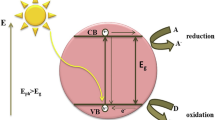
Overview
- Presents the latest studies of metal oxide decorated nanophotocatalyst for pollutants removal from water bodies
- Elaborates the basic synthetic route of the nanophotocatalyst to make highly efficient for water purification
- Outlines the modern design of photocatalytic degradation materials and manufacturing engineering
Part of the book series: Smart Nanomaterials Technology (SNT)
Access this book
Tax calculation will be finalised at checkout
Other ways to access
About this book
This book presents the latest studies of metal oxide decorated nanophotocatalyst for pollutant removal from water bodies. Metal oxide-based nanophotocatalyst is currently considered an efficient material for pollutant removal as compared to other available materials due to its unique characteristics such as low cost, high regenerability, high photocatalytic degradation capacity, environmentally friendly and sustainability. This book elaborates on the basic synthetic route of the nanophotocatalyst to make it highly efficient such as; the presence of active sites, high mechanical strength, conductivity and thermal stability properties. These sustainable and efficient metal oxide-based nanophotocatalyst materials have significant environmental applications and can be applied in different fields. This material has the potential to clean up the different pollutants like volatile organic compounds, CO2 capture, organic and inorganic toxic pollutants, pesticides and colour compounds from the environment. This book gives a sound knowledge of metal oxide-based nanophotocatalyst to the audience regarding the modern design of photocatalytic degradation materials and manufacturing engineering with numerous example illustrations, methods and results for graduate students, researchers and industrialists. Readers will have a quick reference by exploring the research literature on the subject with commercial value-added research applications of metal oxide-based nanophotocatalyst materials.
Similar content being viewed by others
Table of contents (15 chapters)
-
Front Matter
Editors and Affiliations
About the editors
Dr. Akil Ahmad is working at Prince Sattam bin Abdulaziz University, Saudi Arabia, as Assistant Professor in Chemistry and having the experience of seven years as Research Fellow, Teaching Fellow, Postdoc and Visiting Researcher from Universiti Teknologi Malaysia, Universiti Sains Malaysia, University of KwaZulu-Natal, South Africa and Universiti Kebangsaan Malaysia, Malaysia. He has completed Ph.D. in Analytical Chemistry (2011) with the topic “Modification of resin for their use in the separation, preconcentration and determination of metal ions” from Aligarh Muslim University (AMU), India. His research interest in the areas of environmental pollutants and their safe removal, synthesis of nanoparticles and Nano-sorbents (GO, CNT), photo-degradation and antimicrobial effects, water and wastewater treatment and adsorption and ion-exchange.
Dr. Mohammad Jawaid is currently working as Professor at Chemical and Petroleum Engineering Dept, College of Engineering, United Arab Emirates University, UAE. He has more than 20 years of experience in teaching, research and industries. His area of research interests includes hybrid composites, lignocellulosic reinforced/filled polymer composites, advance materials: graphene/nanoclay/fire retardant, modification and treatment of lignocellulosic fibres and solid wood, biopolymers and biopolymers for packaging applications, nanocomposites and nanocellulose fibres and polymer blends. He is 1% Clarivate Highly cited Researcher 2023 and also winner of Several recognition at national and International level.
Dr. Mohammed B. Alshammari currently working at Prince Sattam bin Abdulaziz University in Al-Kharj, Saudi Arabia, as Professor in Organic Chemistry. He received his B.Sc. and M. Sc. degrees in Chemistry from King Saud University, Riyadh, KSA in 2007 under supervision of Professor Abdullah Almajed and Professor Hassan Alhazmi. He worked in Chemistry department in KSU for 9 years as researcher. He received his Ph.D. degree from Cardiff University, UK, in 2013 under supervision of Professor Keith Smith. His research focused in using of organometallic intermediates in organic synthesis. He has published more than 60 International peer-reviewed journal publications and 20 conference proceedings in the area of Organic Chemistry and Chemistry.
Dr. Asma Khatoon has completed Ph.D. in Analytical Chemistry (2011) from Aligarh Muslim University, India. She has one year experience as Postdoc and six months as Visiting Researcher from Centre of Lipids Engineering and Applied Research, Universiti Teknologi Malaysia, Malaysia. Her research interest in the areas of supercritical fluid extraction, pharmaceutical analysis, method validation, synthesis of nanoparticles and Nano-sorbents (GO, CNT), water and wastewater treatment and adsorption and ion-exchange. She has published more than 30 research articles and chapters in the journals and publishers of international repute such as Scientific reports, Arabian Journal of Chemistry, Frontiers in Chemistry, Catalysts, RSC Advances, Desalination and Water Treatment.
Accessibility Information
PDF accessibility summary
EPUB accessibility summary
Bibliographic Information
Book Title: Metal Oxide Based Nanophotocatalyst for Wastewater Purification
Editors: Akil Ahmad, Mohammed B. Alshammari, Mohammad Jawaid, Asma Khatoon
Series Title: Smart Nanomaterials Technology
DOI: https://doi.org/10.1007/978-981-96-7683-5
Publisher: Springer Singapore
eBook Packages: Chemistry and Materials Science, Chemistry and Material Science (R0)
Copyright Information: The Editor(s) (if applicable) and The Author(s), under exclusive license to Springer Nature Singapore Pte Ltd. 2025
Hardcover ISBN: 978-981-96-7682-8Published: 27 September 2025
Softcover ISBN: 978-981-96-7685-9Due: 11 October 2026
eBook ISBN: 978-981-96-7683-5Published: 26 September 2025
Series ISSN: 3004-8273
Series E-ISSN: 3004-8281
Edition Number: 1
Number of Pages: VI, 403
Number of Illustrations: 16 b/w illustrations, 80 illustrations in colour
Topics: Energy Materials, Catalysis, Chemistry/Food Science, general



